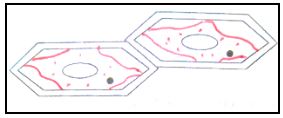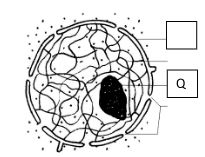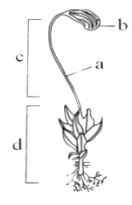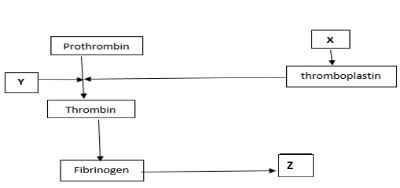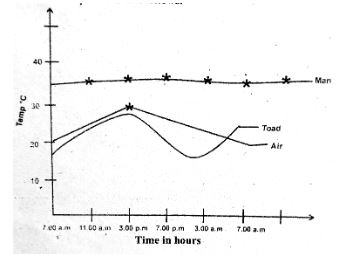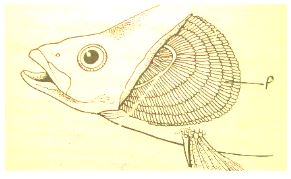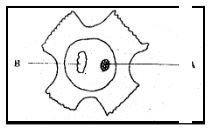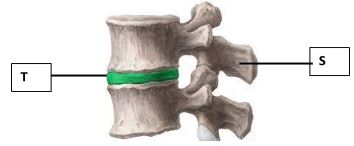Instructions to candidates
- Answer all questions
- Study the diagram below showing a portion of an onion epidermis that had been irrigated with a certain solution X.
- In one word describe the condition of the cells (1mk)
- Describe the process that lead to the condition named above. (3mks)
- The following reaction may proceed in forward or backward direction.
- What term is used to refer to the backward reaction. (1mk)
- In which part of alimentary canal does the backward reaction occur? (1mk)
- Name the enzyme that catalyzes the backward reaction. (1mk)
- The diagram shown below represents a nucleus.
- State the role of the organelle labelled Q (1mk)
- Name a Kingdom whose members lack structure labelled P (1mk
- Which is the general term given to organisms whose cells have structure P? (1mk)
- After fertilization of an ovule, which parts develops into: -
- Testa (1mks)
- Endosperm (1mk)
-
- Explain two roles of diffusion in human beings. (2mks)
-
- Name the process through which a plant takes up some mineral ions against a concentration gradient. (1mk)
- State two factors that may affect the process named in b(i) above. (2mks)
- Distinguish between haemolysis and plasmolysis. (1mk)
- An insect landed on a leaf of an insectivorous plant. Consequently, the leaf closed with its spines interlocking trapping the insect inside it. Name the response exhibited by the leaf. (1mk)
- The figure below represents a plant.
- State the division it belongs to. (1mk)
- Label the parts labeled (2mk)
- State the role of part labeled d in the life cycle of the organism. (1mk)
- State any two adaptations of the cardiac muscle that enable it to undergo systole. (2mks
-
- Why are carbohydrates and not lipids the first choice respiratory substrates? (2mks)
- 2C57H110O6 + 163O2 → 114CO2 + 110H2O + Energy.
Calculate the RQ from the equation in (c) above. (2mks)
- Below is a diagram of a group of cells of a specific tissue.
- Name the tissue (1mk)
- This tissue lines the trachea and bronchi. Suggest its function in these structures. (1mk)
- Study the flow chart below which represents a physiological process in mammals
-
- Name blood components represented by X. (1mk)
- What is the significance of product represented by Z. (2mks)
- Under what condition is thrombokinase released by the platelets? (1mk)
-
-
- Explain what happens to excess amino acids in the liver of humans. (3mks)
- Which portions of the human nephron are only found in the cortex? (1mks)
- A potted plant is transferred from outside on a sunny and windy day, to a dark room.
- Briefly explain the effect this is likely to have on:
- The rate of loss of water from its leaves. (3mks)
- The rate of water absorption. (2mks)
- Briefly explain the effect this is likely to have on:
- Give a reason why urine of a mammal does not contain amino acids. (1mks)
-
- In what form is energy stored in muscles? (1mk)
- State the role of insulin in human body. (2 mks)
- Name the processes that take place in the liver to bring about differences between blood in the Hepatic portal vein and that in the hepatic vein. (3mks)
- The graph below shows how the body temperature of a toad and man varies with time in hours. Study it and answer the questions that follow.
- What is the relationship between the body temperature of the toad and that of the atmospheric air? (1mk)
- State two corrective measures that maintains man’s body temperature at norm even when the environmental temperature is below 30°C. (2mks)
- Give one behavioral adaptation observed in a lizard when the environmental temperature is above 39°C. (1mk)
- The figure below shows the exposed breathing apparatus of a fish.
- Name the structure that was removed to expose the apparatus. (1mk)
-
- Name structure P. (1mk)
- State two structural adaptations of the respiratory surface in insects. (2mks)
- The following is a reproductive structure of a plant.
- Identify the structure. (1mk)
- Name the sub-division of the plants that produces the above reproductive structure. (1mk)
- Name structure B. (1mk)
- What is the function of structure A? (1mk)
- Nucleic acids are made up of nucleotides that bears a sugar component.
- Name the sugar component found in: - (2mks)
- DNA fragment
- RNA fragment
- The following nucleotide sequence was found in a segment of DNA: - A G C C T. Write down the complementary base sequence in the corresponding m RNA segment during transcription. (1mk)
- A point mutation altered the base sequence from the original to G G C C T. Identify the type of gene mutation. (1mk)
- Name the sugar component found in: - (2mks)
- Below is a drawing of a cell.
- With two reasons, identify the cell. (2mks)
Identify.
Reasons: - Which of the three structure X, Y and Z speeds up transmission of the impulse. (1mk)
- With two reasons, identify the cell. (2mks)
-
- State two structural differences between skeletal muscles and smooth muscles. (2mks)
Skeletal muscle Smooth muscle (i) (ii) - What are antagonistic muscles? (1mk)
- State two structural differences between skeletal muscles and smooth muscles. (2mks)
- Name the substrates for the following enzymes
- Carbonic anhydrase (1mk)
- Cholinesterase (1mk)
- A tilapia fish has a full length of 300mm but measures 200mm from the mouth tip to its anus. Determine the tail power of the fish (2mks)
- State the differences between cones and rods in terms of the following (2mks)
Feature Cone Rod Visual acuity Photochemical - Impulse transmission across a synapse is in one direction. Explain (2mks)
- The diagram shown below represents a section of the vertebral column
- Name the part labelled S (1mk)
- State TWO ways in which part T is important to movement in human beings (2mks)
- Give TWO features that make modern man to be more adaptable to the environment (2mks)
MARKING SCHEME
-
- Hypertonic;
- The cell sap was hypotonic to the solution X; hence water was drawn from the cell into the solution by osmosis; making the cytoplasm to shrink and cell membrane detach from the cell wall;
-
- Hydrolysis;
- Ileum;
- Sucrase;
-
- At K/ between K and L
- The inhibitor blocked the active sites of enzymes; that converts K to L; hence accumulation of K and near absence of L,M and N;
- Enzyme activator;
-
- Integuments;
- Primary endosperm nucleus;
-
- Absorption of digested food such as glucose and amino acids; into the blood stream;
- Exchange of respiratory gasses ie oxygen and carbon(iv) oxide; between the alveolus and blood capillaries;
- Excretion of nitrogenous wastes such as urea; from the blood capillaries into elimination site; ( Any two)
-
- Active transport;
-
- Low oxygen concentration;
- lowering temperature below optimum level;
- Presence of enzyme inhibitors; (Any two)
-
- Haemolysis - A process by which red blood cells take up water from a solution of lower solute solution by osmosis till they burst. OWITTE
- Plasmolysis – A process by which plants cell loss water to a solution of higher solute concentration by osmosis and becomes flaccid; OWITTE
- Absorption of digested food such as glucose and amino acids; into the blood stream;
- Thigmonasty / Haptonasty; Rej. positive thigmonasty.
-
- Bryophyta;
-
- a- Seta;
- b -Capsule;
- Produces gametes whose fusion gives rise to the sporophyte generation/C;
-
- Has a specialized region on the right atrium / pace maker known as sinoatrial node;
Rej SAN - Has a specialized muscle region at the boundary between atria and ventricle called atrio-ventricle node that spreads the contractions.
- Muscle cells are interconnected to enable spreading of the wave of contractions; ANY TWO
- Has a specialized region on the right atrium / pace maker known as sinoatrial node;
-
- 2C57H110O6 + 163O2 → 114CO2 + 110H2O + Energy.
-
- They are easily transported.
- They require less oxygen for their oxidation.
- 104 CO2 ; = 0.669 ;
163 O2
-
- (Ciliated) epithelial tissue.
- It wafts mucus with trapped dust/solid particles.
-
-
- Platelets;
- Forms a clot that prevents excessive bleeding/prevents entry of pathogens;
- When platelets are exposed to air;/ When platelets clump together and adhere to the wall of damaged blood vessel;
-
-
- Excess amino acids are deaminated in the liver; with formation of ammonia; which reacts with carbon oxide to form urea, an excretory waste material.
-
- Bowman’s capsule;
- Proximal convoluted tubule;
- Distal convoluted tubule ; - ( All tied)
-
- Rate of loss of water reduces; because temperatures lowers and windy conditions reduced; reducing rate of transpiration.
- Rate of water absorption reduces; because rate of transpiration / water loss reduces hence less water needs to be replaced;
- All amino acids are re-absorbed in the proximal convoluted tubule / kidney nephron;
-
- Adenosine-triphosphate; Rej ATP
- Insulin increased permeability of kidney tubules; increasing water re-absorption; when the body fluid’s osmotic pressure is below normal.
-
- Deamination
- Blood sugar regulation.
- Respiration
- Detoxification
-
- The toad’s temperature fluctuates with the fluctuations of atmospheric air temperature.
-
- Increased respiration to generate more heat.
- Vasoconstriction thus less blood flowing to the skin reducing heat loss.
- Contraction of erector pili muscles raising the hairs (to upright position) trapping a layer of air that insulates the body against heat loss.
- Shivering to generate heat;
- Reduced or no sweating reducing heat loss; (Any three)
- Moves to cooler place / move to shade;
-
- Operculum;
-
- Gill filament;
- Are always moist for gasses to dissolve and diffuse in solution;
- They (tracheoles) are branched to increase surface area to serve every cell;
- They have thin wall to reduce distance of diffusion of gasses; (ANY TWO)
-
- Pollen grain;
- Angiospermaphyta / Angiospermae / Angiospermatophyta;
-
- Generative nucleus;
- Directs the growth of pollen tube through the style towards the micropyle;
-
-
- Deoxyribonucleic acid;
- Ribonucleic acid;
- U-C-G-G-A;
- Substitution;
-
-
- Motor neurone;
Reasons- Cell body is found at the end of the axon;
- It is multipolar / from the cell body projects several dendrones;
- Has effector dendrites that terminates at the effector muscle/ skeletal muscle; (ANY TWO)
- Motor neurone;
-
-
Skeletal muscle Smooth muscle i) Attached to the skeleton Found lining the inner walls of tubular structure ii) Striated Unstriated ii) Their cells / fibres are multinucleated. Cells have one nucleus - Muscles that work as a pair ,when one contracts the other one relaxes to cause movement;
-
-
- Carbonic acid
- Acetylcholine
Tail power = length from the tail tip to the anus
length from the tail tip to the mouth
= 300 x 100 = 150%
200
Feature Cone Rod Visual acuity High resolution Low resolution Photochemicalphotopic vision scotopic vision - Receptors for the neurotransmitter are most numerous on the postsynaptic (receiving) cell.
-
- Spinous process
-
- Shock absorber
- allow movement between adjacent vertebral bodies
-
- Genetic changes
- Cultural practices and technology
Download Biology Paper 1 Questions and Answers - Lugari Constituency Joint Pre Mock Exams 2023.
Tap Here to Download for 50/-
Get on WhatsApp for 50/-
Why download?
- ✔ To read offline at any time.
- ✔ To Print at your convenience
- ✔ Share Easily with Friends / Students

